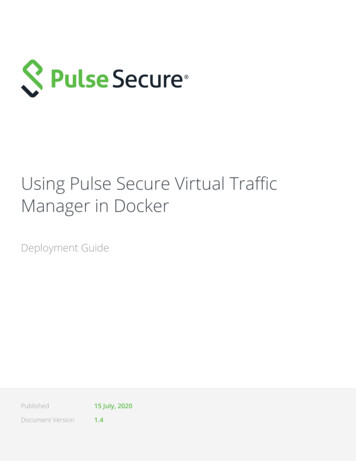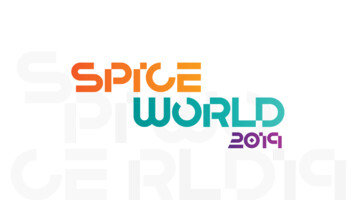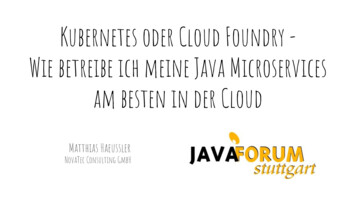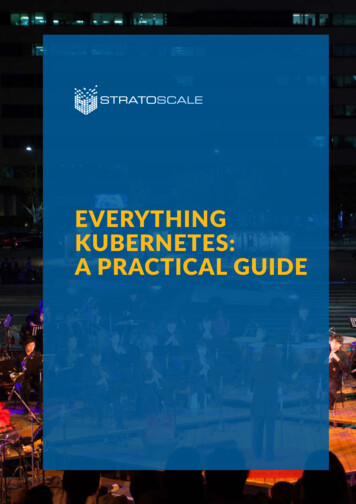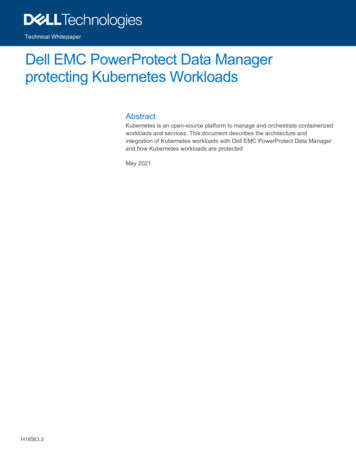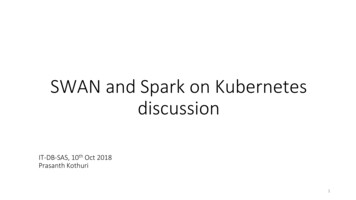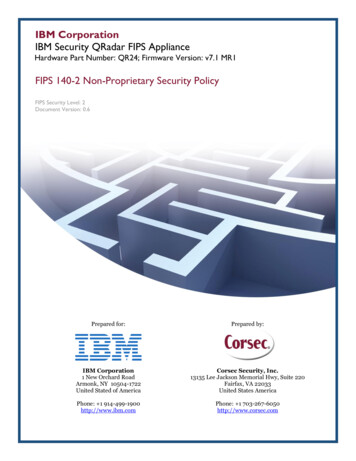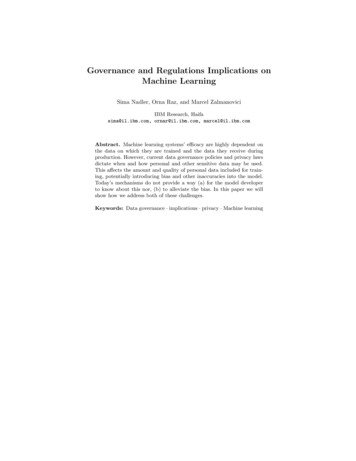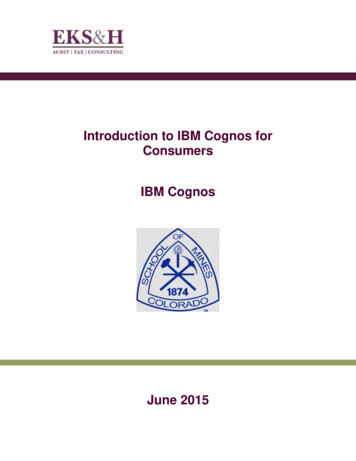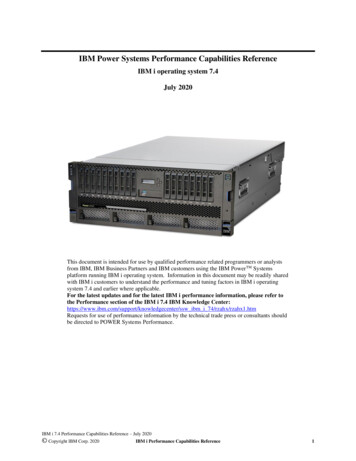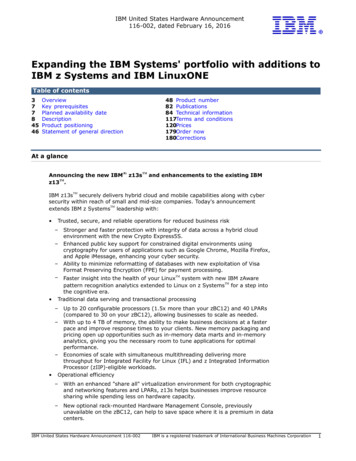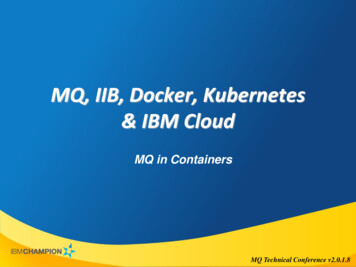
Transcription
MQ, IIB, Docker, Kubernetes& IBM CloudMQ in ContainersMQ Technical Conference v2.0.1.8
MQ in the Cloud Content Containers Container Software Stack Open Systems Interconnection (OSI) Layers Differing Perspectives Challenges of porting networks into Containers Summary2MQ Technical Conference v2.0.1.8
MQ in the Cloud - ContainersContainersThe new Application Runtime Environment3MQ Technical Conference v2.0.1.8
Containers What are Containers? They are a type of Virtual Machine. They are very lightweight; more like a “Virtual Thread”. They all are based on Linux. Where did Containers Come From? First released in 2013. Adopted by Amazon in 2014. 2016 Contributors: Docker, Cisco, Google, Huawei, IBM, Microsoft, Red Hat. Why are Containers Important? Standardized configuration allows “run anywhere” behavior. Enable massive horizontal scaling. Foundational technology for Amazon, Microsoft, & IBM Clouds.4MQ Technical Conference v2.0.1.8
How Containers are Built Containers are defined by a “Dockerfile” The Dockerfile is a build script The Dockerfile defines a container as a series of layers The Initial layer is required to be a Linux image The second layer could be, for example, the MQ binaries Containers have a defined command/script to be executed at startup Two Methods for adding a Queue Manager to a Container Add a named Queue Manager and it’s MQ objects as a layer But every instance of the container would contain the same Qmgr! Define a new Queue Manger in the startup script But how to define communications to and from the Qmgr? To cover this dilemma in more depth, additional background is needed5MQ Technical Conference v2.0.1.8
MQ in the Cloud – Cloud Software StackContainer Software StackIt’s a whole new ballgame6MQ Technical Conference v2.0.1.8
Cloud Software Container Stack Remote Facilities Bare Metal Network Storage Compute IaaS OS PaaS DB & Mgmt Middleware App Hosting SaaS 7 ApplicationMQ Technical Conference v2.0.1.8
Container Stack Docker The engine that runs a container (a new kind of hypervisor) Dockerfile defines which Ports of the Container are exposed Provides communication support within a server Kubernetes Kubernetes is a Container manager Monitors health and restarts containers Provides dynamic horizontal scaling of containers Provides communications support across servers Helm Helm is a Kubernetes package manager Istio A Services Mesh Provides communications support through a Control Plane8MQ Technical Conference v2.0.1.8
Docker Developed by SolomonHykes Released in 2013 Uses Linux features cgroups Namespaces “Union” file system Union file system Open Source Open Container Initiative Cloud Native ComputingFoundation9MQ Technical Conference v2.0.1.8
Docker Notes - INOT Conceptual Framework Software executes in “Containers” Containers are based upon native Linux capabilities A Container is a single isolated & encapsulated thread Everything necessary to execute (i.e. libraries) A Container is a run-time instance of an “Image” Images stored in Docker registries Containers are managed by a daemonE dockerd (Docker container daemon)containerd (Open Source container daemon)Container isolated from all other non-kernel processesScope of daemon is only server wideS10MQ Technical Conference v2.0.1.8
Docker Notes - IINOTE Virtual Machines versus Containers Virtual Machines Implement a “virtual” Operating System General purpose Multi-threaded Shared resources for multiple processes Slow to start up and shut down Containers Implement a “virtual” Thread Execute a single program Single-threaded (Single Linux thread) Resources dedicated to the software image Extremely fast to start up and shut downS11MQ Technical Conference v2.0.1.8
Kubernetes Developed by Google Released in 2015 Turned over to theCloud NativeComputing Foundation(CNCF) ”Clustering forContainers” Docker Swarm andApache Mesos arecompeting products12MQ Technical Conference v2.0.1.8
Kubernetes NotesNOT Container Orchestration Cluster ManagementContainer SchedulingService DiscoveryDynamic Scaling (Managing Container instances)Health Maintenance (Health Checking & Repair) Single Docker instance only spans one server Kubernetes deploys “Pods” of ContainersE Pods contain one or more containers Pod instances deployed across multiple servers Number of Pod instances monitored and managedS13MQ Technical Conference v2.0.1.8
Kubernetes ArchitectureNO Kubernetes Clusterdefined by Masternode. Pods distributedacross Worker nodes.T Client controlinterface.E Defined Pods andServices.S14MQ Technical Conference v2.0.1.8
Helm Developed at Deis Released in 2015 ”Packaging forKubernetes” Turned over to theCloud NativeComputing Foundation(CNCF) Initial developmentstarted with a short Deishackathon15MQ Technical Conference v2.0.1.8
Helm NotesNOTES16 Package Manager for Kubernetes Provides “Helm” Charts A Helm Chart is a zipped directory (chart name directory) Package multiple Kubernetes components into one chartooooPodsServicesIngressVolumes Separate Manifest data from Environment data Charts can be stored and versioned in a repository A “Release” is an instance of a Chart Simplifies managing deployments Combines multiple Kubernetes actions into a single chart Creates a single reusable set of deployed objects (manifest) Isolates Environment settings for simplified deployment migration(e.g. from Development to Production)MQ Technical Conference v2.0.1.8
Helm Directory StructureNOTE Helm Chart Directory Chart.yaml (Chart metadata; YAML format)LICENSE (L) - optionalREADME.md (Text file formatted using Markdown) - optionaltemplates (Resource manifests; Directory)o NOTES.txt (Text file)o helpers.tpl (Text file)o configmap.yaml (YAML file)o deployment.yaml (YAML file)o pvc.yaml (YAML file)o secrets.yaml (YAML file)o svc.yaml (YAML file) values.yaml (Release Keys and Values; YAML format)S17MQ Technical Conference v2.0.1.8
Helm ArchitectureNOTES18MQ Technical Conference v2.0.1.8
Istio Developed by IBM,Google, & Lyft Released in 2017 Service Discovery(“Dynamic DNS”) forthe Cloud Consolidation of theAmalgam8 (IBM),Service Control(Google), and EnvoyProxy (Lyft) projects19MQ Technical Conference v2.0.1.8
Istio NotesN The Problem: How can the location of a Service be determined?O The Answer:TES20 A Service Mesh Envoy Proxies are added as “sidecars” to Docker containers These sidecars are deployed as part of the Kubernetes Pod TCP requests routed through the Proxies. Proxies announce their existence to the “Control Plane”o This allows them to receive inbound traffic Proxies route their requests through the “Control Plane”o This allows them to receive inbound traffic Control Plane may also enforce Policies (Security, Traffic, etc.)MQ Technical Conference v2.0.1.8
Istio ArchitectureNOTES21MQ Technical Conference v2.0.1.8
MQ in the Cloud - ContainersOpen SystemsInterconnection LayersDecomposing the Software Stack22MQ Technical Conference v2.0.1.8
Open Systems Interconnection Layers Application perspectiveis OSI Layer 7 Apps are all about“function” MQ is an OSI Layers 4 &5 product Reasoning that what is“good” for Layer 7 willbe good for other layersIS NOT VALID!23MQ Technical Conference v2.0.1.8
MQ in the Cloud - ContainersDiffering PerspectivesWhat you don’t know seems simple24MQ Technical Conference v2.0.1.8
Application View of MQ25MQ Technical Conference v2.0.1.8
MQ View of Applications26MQ Technical Conference v2.0.1.8
Network View of Servers27MQ Technical Conference v2.0.1.8
Perspectives - I Application Developers Containers provide a standardized runtime environment (through Dockerfiles) Every Container is, by definition, configured identically Containers provide horizontal scaling (through Kubernetes) Containers provide HA (through Kubernetes) Influenced by Web Front-ends using clustered horizontal scaling Enterprise Architects Back-end software may also leverage horizontal scaling Read-only resources may be horizontally scaled (multiple instances) Single-instance resources, however, are placed in their own container Transactional Databases may only have one logical copy28MQ Technical Conference v2.0.1.8
Perspectives - II MQ Administrators See Application Front-Ends See Application Back-Ends See MQ as a Network, not as a Service Network Engineers See the actual network Understand routing and load balancing AT THE NETWORK LEVEL Do Not see routing and load balancing AT THE SERVER LEVEL29MQ Technical Conference v2.0.1.8
Perspectives & Skills Multiple roles required to deploy Cloud Applications Cloud developer (Programmer) & Cloud deployer (DevOps) Infrastructure, Middleware, & Cloud Administrators Network Engineers & Security Administrators You Don’t Know What You Don’t Know You know your owner complexities You may not know, or may underestimate, complexities of other roles It takes a village to nurture software and the village is growing MQ Administrators MUST learn about the Cloud It’s NOT just another computing location It’s an entirely new Software Stack; from top to bottom The only thing in common is Linux, but even that doesn’t translate Network knowledge is even more important now30MQ Technical Conference v2.0.1.8
MQ in the Cloud - ContainersChallenges of PortingNetworks into ContainersA Square Peg in a Round Hole31MQ Technical Conference v2.0.1.8
MQ in the Cloud (in Containers) - I MQ designed for a server based environment Communications through DNS or TCP addresses Server addresses (both DNS and IP) relatively static Server address changes not expected to update in real time Containers designed for a very dynamic environment Container instances continuously created and destroyed Container instances running across multiple servers & data centers Most containers don’t need to persist data Data persistence requires shared disk MQ Challenges Channel definitions (CONNAME) Cluster membership Queue Manager location for Applications to read messages32MQ Technical Conference v2.0.1.8
MQ in the Cloud (in Containers) - II Three patterns of Application Communications Asynchronous Writers/Publishers Request/Reply processing Asynchronous Readers/Subscribers MQ Writer/Publisher and Request/Reply Processing From an Application perspective, MQ provides all of the “magic” tomake Asynchronous Writes and Request/Reply processing work! Therefore, these seem logical to Application developers and architectsto containerize. But how will these containers communicate with other Qmgrs? Built-in Sender channels? How about, if needed, Receiver channels?33MQ Technical Conference v2.0.1.8
MQ in the Cloud (in Containers) - III MQ Reader/Subscriber and Processing From an Application perspective, how can the Application connect toan unknown Queue Manager at an unknown location? But how will these containers communicate with other Qmgrs? Built-in Sender channel definitions assume destination stability. How about, if needed, Receiver channels? How would thecorresponding Sender channels be defined? All Queue Managers Persisting messages requires usage of shared disk Shared disk limits location of servers that can host the container Much closer integration with network configuration e.g. F5 Global Traffic Management (GTM) DNS routing e.g. FT Local Traffic Management (LTM) Load Balancing34MQ Technical Conference v2.0.1.8
IIB/ACE in the Cloud (in Containers) Both MQ and TCP Design considerations If MQ is only used locally by IIB/ACE then no issues If MQ connects with other Qmgrs, then same MQ issues TCP issues can be handled by incoming Load Balancing TCP based services require a “Global” front-end address Standard Istio Service Mesh processes could handlelocal Service registration35MQ Technical Conference v2.0.1.8
MQ in the Cloud - ContainersSummaryAnchored at the shore of the New World36MQ Technical Conference v2.0.1.8
The Potential for Containers High Availability A specific Queue Manager, using shared disk, could potentially runon any server capable of connecting to the shared disk Kubernetes managed HA would potentially seem to be highlydesirable Horizontal Scaling (up to Extremely Large scales) Already possible for some MQ Communication Patterns Asynchronous Writer/Publisher Request Reply Already possible for IIB TCP based Services Global Service Address Local registration using Istio37MQ Technical Conference v2.0.1.8
Questions & Answers38MQ Technical Conference v2.0.1.8
Presenter Glen Brumbaugh– Glen.Brumbaugh@TxMQ.com Computer Science Background– Lecturer in Computer Science, University of California, Berkeley– Professorial Lecturer in Information Systems, Golden Gate University, San Francisco WebSphere MQ Background (25 years plus)– IBM Business Enterprise Solutions Team (BEST)o Initial support for MQSeries v1.0o Trained and mentored by Hursley MQSeries staff– IBM U.S. Messaging Solutions Lead, GTS– Platforms Supportedo MVS aka z/OSo UNIX (AIX, Linux, Sun OS, Sun Solaris, HP-UX)o Windowso iSeries (i5OS)– Programming Languageso C, COBOL, Java (JNI, WMQ for Java, WMQ for JMS), RPG39MQ Technical Conference v2.0.1.8
40MQ Technical Conference v2.0.1.8
MQ Technical Conference v2.0.1.8. 5. How Containers are Built. Containers are defined by a “Dockerfile”. The Dockerfile is a build script The Dockerfile defines a container as a series of layers The Initial layer is required to be a Linux image The second layer could be, for example, the MQ binaries Containers have a defined command/script to .
